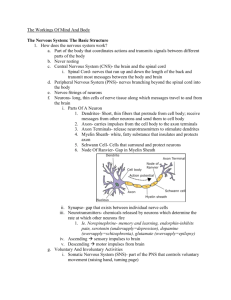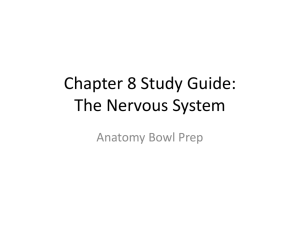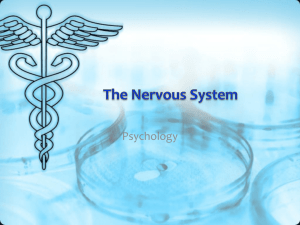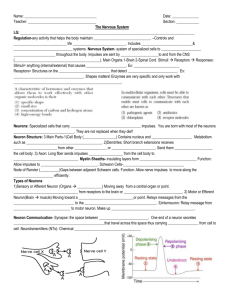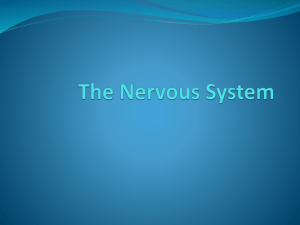Nervous System Test: Anatomy & Physiology
advertisement
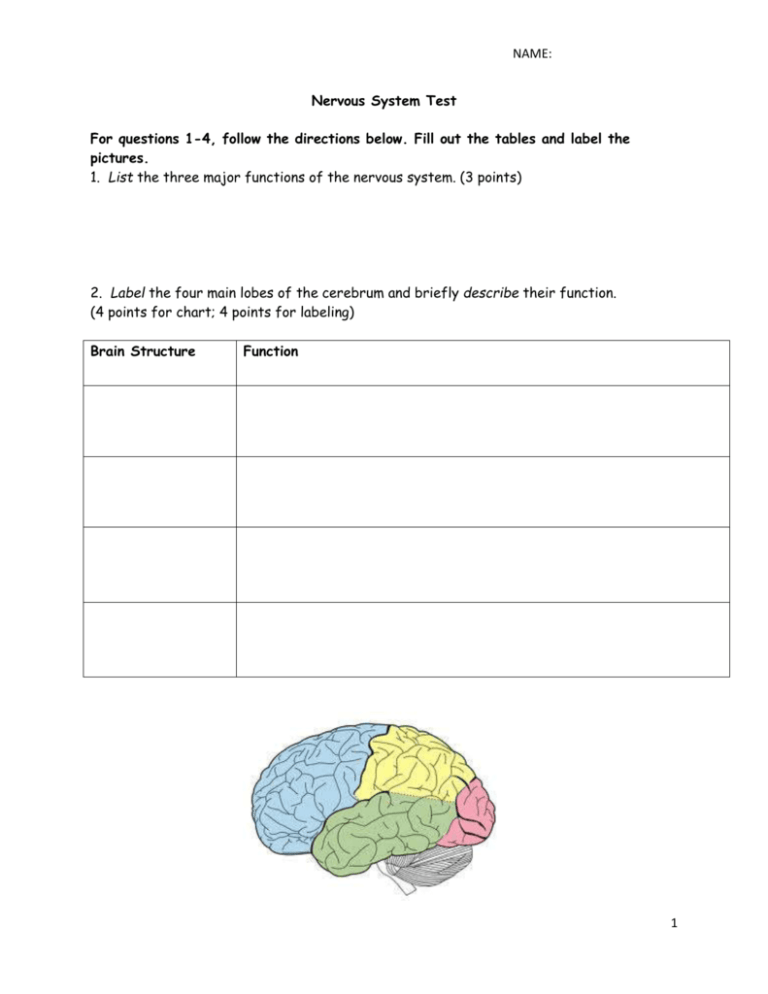
NAME: Nervous System Test For questions 1-4, follow the directions below. Fill out the tables and label the pictures. 1. List the three major functions of the nervous system. (3 points) 2. Label the four main lobes of the cerebrum and briefly describe their function. (4 points for chart; 4 points for labeling) Brain Structure Function 1 NAME: 3. Identify the three layers of meninges covering the brain and describe the structure AND function of each. (6 points for chart; 3 points for labeling) Meninges Structure Function Only label the three meninges. 4. Classify each of the three neurons below according to their structure. (3 points) 2 NAME: For the multiple choice questions below, write the letter in the blank to the left of the question. Each question is worth 1 point. _____ 5. The cerebrospinal fluid is continuously formed by the: A. Corpus callosum B. Choroid plexuses C. Spinal cord D. Pituitary _____ 6. The cerebrospinal fluid is continuously drained by the _____ into the superior sagittal sinus and eventually the bloodstream: A. Arachnoid villi B. Choroid plexuses C. Dura mater D. Pia mater _____ 7. The following three cranial nerves are purely sensory: A. Facial, Trochlear, Olfactory B. Trochlear, Oculomotor, Optic C. Olfactory, Optic, Oculomotor D. Olfactory, Optic, Vestibulocochlear _____ 8. The cell bodies of the sensory neurons that enter the spinal cord are found in: A. Ventral root of the spinal nerve B. Gray matter of the spinal cord C. White matter of the spinal cord D. Dorsal root ganglion _____ 9. The gray matter in the CNS contains ______, and it is located in the _____ portion of the cerebrum and the ______ portion of the spinal cord. A. Neuronal cell bodies; inner; outer B. Myelinated axons ; inner; outer C. Neuronal cell bodies; outer; inner D. Myelinated axons; outer; inner 3 NAME: For the questions 10-11, match the correct structure to the function. 10. Match the cranial nerves with their major function(s). (6 points) A. B. C. D. E. F. G. H. I. J. K. L. Olfactory (I) Optic (II) Oculomotor (III) Trochlear (IV) Trigeminal (V) Abducens (VI) Facial (VII) Vestibulocochlear (VIII) Glossopharyngeal (IX) Vagus (X) Accessory (XI) Hypoglossal (XII) ____ Motor and sensory fibers for the tongue ____ Sensory impulses for balance & hearing ____ Motor impulses for facial expressions ____ Motor impulses to sternocleidomastoid & trapezius muscles ____ Sensory impulses for sense of smell ____ Parasympathetic fibers for digestive & heart activity; Motor impulses to throat 11. Match the neuroglia with their major function(s). (6 points) A. B. C. D. E. F. Astrocyte Microglial cell Ependymal cells Oligodendrocyte Schwann cells Satellite cells ____ Control chemical environment of the brain; Form barrier between neurons & blood ____ Produce myelin sheath for CNS neurons ____ Provide cushion to PNS neuronal cell body ____ Produce myelin sheath for PNS neurons ____ Phagocytic cells that dispose of dead brain cells & bacteria ____ Ciliated cells that circulate cerebrospinal fluid For questions 12-20, answer the short answer questions. You may use bullet points and do not need complete sentences. 12. Relate the nervous system to two other body systems. (2 points) 4 NAME: 13. Compare and contrast neurons and neuroglia. (2 points) 14. Differentiate between an injury to the Broca’s area of the brain versus an injury to the Wernikes area. (2 points) 15. Differentiate between myelinated versus unmyelinated neurons and describe how each impact nerve impulses. Relate your answer to Multiple Sclerosis (MS). (4 points) 16. Describe one thing you learned after dissecting the sheep’s brain. (1 point) 5 NAME: 17. Diagram the breakdown of the Peripheral Nervous System (PNS). (6 points) CNS PNS 18. Explain how neurotransmitters form in the presynaptic neuron and are passed to the postsynaptic neuron. You may draw picture and include numbered steps, if you would prefer. (4 points) 6 NAME: 19. Analyze why the brain has many elevated ridges and shallow grooves. What are these ridges and grooves called, respectively? (3 points) For questions 21-23, write in complete sentences and use as much detail as possible. These “essay” questions are worth more points! You may draw pictures if it helps. 21. Illustrate a nerve impulse in a multipolar neuron, indicating its direction and where it begins and ends. Explain the entire process (in writing) with as much detail as possible. Include in your explanation K+ and Na+ concentrations when the neuron is polarized and depolarized, how these concentrations change, how the action potential is generated, and how the “message” is passed to the next neuron. (10 points) 7 NAME: 22. Differentiate between the two divisions of the autonomic nervous system. Include how they differ in their functions, structures, and neurotransmitters. What are their nicknames? Include where the cell bodies and axon terminals of each neuron are located. Draw a picture to help explain your answers. (8 points) 23. Analyze the effects of TTX on the nervous system from the molecular level to the visible effects on the body. Relate this to anesthetics and how they function. (6 points) 8 NAME: 24. How would a drug that inhibits the parasympathetic division affect a person’s pusle? (2 points) Questions 25-27 are clinical/application questions. Provide EVIDENCE and REASONING from what you have learned about the nervous system when explaining your answer. Each answer is worth 5 points. 25. Johnny was in a car accident in which the car was T-boned and his head hit the passenger window, shattering it. He was alert and conscious after the accident, but he had an intense headache. An hour later he was in the hospital in a coma. What is the likely cause of Johnny’s deterioration? 27. In the article “The Natural High”, if a person partakes in frequent risky behaviors by taking/engesting/smoking exogenous cannabinoids, what could happen to their natural, endogenous endocannabinoids in their? What happens if the person all of a sudden stops their cannabinoid use? 9 NAME: Answer each short answer Extra Credit question below with as much detail as possible. Each question is worth 2 points of extra credit. 1. A person is paralysed from the neck down due to an injury severing the spinal cord. Is it possible for this person to exhibit reflexes, such as the knee-jerk reflex? Why or why not? 2. Why does exposure to toxins (such as alcohol) have more devastating neural effects during early pregnancy than in late pregnancy? 3. What is the difference between flaccid and spastic paralysis? 10


